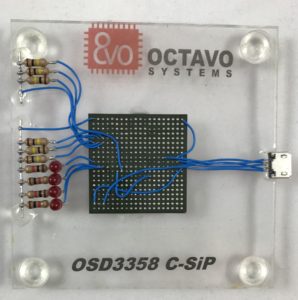
Gene Frantz
Posted on November, 12, 2019
Categories
Recent Posts
- Octavo Systems Unveils the OSD32MP2 Series: Revolutionizing System Design in the Electronics Industry April 9, 2024
- Securing the Future: The Integral Role of SiP Technology in Thwarting Physical Attack Vectors in Embedded Systems March 12, 2024
- Developing Secure Embedded Systems: Best Practices and Strategies March 12, 2024
- Heterogeneous Integration (HI) and System-in-Package (SiP) Technology: A Comprehensive Overview February 20, 2024
- Understanding The Differences Between System-on-Chip (SoC), Package-on-Package (PoP), System-on-Module (SoM), and System-in-Package (SiP) January 17, 2024
Our Journey to an Elektra Award Nomination
Once again we are among an impressive list of finalists for an important industry award. This time it is for one of the Elektra Awards (electraawards.co.uk). Thank you to our customers and the esteemed list of judges for recognizing the uniqueness of our System in Package and promoting us to finalist for the “Internet-of-Things Product Innovation Award”. We are honored to be among 14 companies, all with very impressive entries, most of whom are over 100 times our size. (For details of not only the award for which we are a finalist but all of the categories go to https://www.elektraawards.co.uk/elektraawards2019/en/page/2019-products-shortlist )
Our C-SiP Story
Our entry is the OSD335x C-SiP – A complete System-in-Package. It is the result of our pursuit to use SiP technology to create components that act like systems. Specifically, our goal with this device was to integrate a complete computer into a single package. The C-SiP, the third device in our OSD335x family of SiPs, accomplishes this by integrating everything you need to run a 1GHz embedded Linux computer in a single package. It is the result of our continual push to integrate more of the system into that one semiconductor package. This is just the next step in our continuous movement toward the ultimate SiP. Let me take a minute to better describe this journey.
Figure 1 visualized the ultimate system along with were we are on the evolutionary path toward it. Our first device on the path to the ultimate System in Package was the OSD3358-BAS. Figure 3 is an enlargement of where we are today, the C-SiP. At the far right of Figure 1, is the ultimate SiP. (I will explain that later)

The back story
The OSD3358-BAS, was (and still is) a 27mm by 27mm BGA package with 400 balls and 1.27mm ball spacing. It had integrated into the package an AM3358 processor from Texas Instruments along with its associated Power Management Integrated Circuit (PMIC) and 4Gb DDR3 memory (later an 8Gb memory became available). To the surprise of many it was functional on our first pass and was immediately put into production.
Our second step, was to reduce the size of the package to 21 X 21mm while adding a couple more devices to the SiP. For this second device, the OSD335x-SM, we reduced the number of balls in the BGA to 256, still at 1.27mm center to center spacing without sacrificing any functionality. The reasons the reduction in the number of balls is possible are:
- The reduced number of power rails needed to be brought on to the SiP, because of the integrated PMIC only a single power rail is needed.
- Removing the need for the DDR3 address, data and control signals to be brought out for external connections.
This reduction in the number of required external connections allowed us to intelligently layout the 256 Balls on the OSD335x-SM so that all the AM335x signals can be escaped and routed in a single layer. Our latest step in this integration journey led us to the OSD335x C-SiP (C-SiP) which is the device on the short list. Figure 2 shows a block diagram of the C-SiP. The significant addition to the device was the eMMC. With it and the on board oscillator, the C-SiP became a complete computer in a package.


Figure 3 shows a demo platform we used to show what it means to actually be a computer in a package. You can see that we have connected the C-SiP to the outside world just by soldering wires to the power and ground inputs of the PMIC (No PCB Required). Once powered up the C-SiP boots Debian Linux and begins to communicate using a USB port.
The rest of the story
You can summarize what we have done is to reduce the number of external connections for a single chip computer (SCC) from 400 balls to 256 balls to 10 balls. As the ultimate goal is to create an SCC with no external connections, you can easily see that we are well on the way. Which brings me back to Figure 1. The ultimate goal is to create smart dust. In other words integrating a functional computer to a point where there is no physical external connectors – the Ultimate SiP. It means the SSC creates its own power, does its own processing and communicates using wireless methods. We have code named this next step as Chiclet after the gum. But there is are further steps of continuous shrinking until the computer is the size a dust.
We are honored to be among the finalists for the progress we have made so far and are impressed by the company we are keeping. We will continue to push SiP technology until we have the Ultimate SiP and made it the size of dust!
Find Out if We Win and Stay Up to Date on the Latest from Octavo Systems. Sign Up for our Mailing List!
"*" indicates required fields
